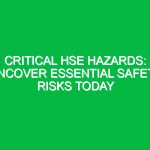In the realm of Health, Safety, and Environment (HSE), the clarity and accuracy of definitions are paramount. A poorly trained definition can lead to misunderstandings, miscommunications, and potentially hazardous situations. This article delves into the implications of poorly defined terms within the HSE context, exploring their significance, the risks they pose, and the Best Practices for ensuring clarity and precision in HSE communication.
Understanding Poorly Trained Definitions
A poorly trained definition refers to a term or phrase that lacks clarity, is inadequately explained, or is misused within its context. In HSE, where precise language is essential for ensuring compliance, safety, and effective communication, such definitions can create significant challenges. For instance, the term “hazard” might be used without a clear distinction between “hazard” and “risk,” leading to confusion among employees regarding Safety protocols.
In essence, a poorly trained definition can undermine the very goals of HSE practices. When individuals misunderstand critical terms, the consequences can range from non-compliance with Safety Regulations to increased injury rates and environmental degradation. It is crucial to address these poorly defined terms to foster a culture of safety and awareness.
The Impact of Poorly Trained Definitions on HSE
Consequences of Misunderstanding
One of the most immediate impacts of poorly trained definitions in HSE is the potential for miscommunication. For example, if “personal protective equipment” (PPE) is vaguely defined, workers may not fully understand the importance of using specific gear for certain tasks. This misunderstanding can lead to inadequate protection and increased risk of injury.
Regulatory Compliance Risks
Another critical aspect relates to regulatory compliance. HSE regulations often hinge on precise terminology. A poorly defined term might lead organizations to misinterpret legal requirements, resulting in compliance failures and legal ramifications. For instance, if a company misinterprets the definition of “exposure limit” due to a lack of clarity, it may fail to implement necessary monitoring Procedures, exposing employees to harmful substances beyond acceptable levels.
Increased Liability
Organizations can face increased liability when poorly trained definitions contribute to accidents or incidents. If an employee is injured because they misunderstood a safety procedure due to vague language, the company could be held liable. Clear definitions are vital not only for compliance but also for protecting both employees and employers from potential legal issues.
Key Components of Effective HSE Definitions
Clarity and Precision
Effective definitions in HSE must be clear and precise. They should eliminate ambiguity, providing employees with an unambiguous understanding of the terms used in safety protocols. For example, instead of defining “chemical exposure” as “contact with chemicals,” a clearer definition might state, “chemical exposure refers to any situation where an employee comes into contact with hazardous substances through inhalation, skin absorption, or ingestion.”
Contextual Relevance
Definitions should also be contextually relevant. This means that the terms must be tailored to the specific industry or environment in which they are used. For example, the definition of “confined space” varies between construction and manufacturing. Understanding the specific context ensures that employees are trained appropriately for their unique work environments.
Consistency Across Documentation
Consistency is crucial when defining terms within HSE documentation. All Training materials, safety manuals, and incident reports should use the same definitions to avoid confusion. A lack of consistency can lead to misunderstandings and dangerous situations. For instance, if one document defines “emergency” differently than another, employees may respond incorrectly during a crisis.
Best Practices for Defining HSE Terms
Collaborative Development of Definitions
Involving a diverse group of stakeholders in the development of definitions can enhance clarity and accuracy. Engaging employees, safety professionals, and management in discussions about key terms ensures that definitions reflect practical realities and are understood across various levels of the organization. This collaborative approach can lead to a more robust understanding of safety protocols.
Regular Reviews and Updates
HSE definitions should not be static. Regular reviews and updates are essential to ensure that definitions remain relevant as regulations change or as new Hazards emerge. For example, with the increasing prevalence of remote work, definitions related to Workplace Safety may need to evolve to encompass new risks associated with home office setups.
Training and Awareness Programs
Implementing training and awareness programs focused on HSE definitions is vital. Employees should receive training that emphasizes the importance of understanding key terms and definitions. This not only promotes safety but also fosters a culture of accountability and awareness. Workshops, seminars, and online training modules can be effective tools for enhancing understanding.
Real-Life Examples of Poorly Trained Definitions in HSE
Case Study: The Chemical Manufacturing Industry
In a chemical manufacturing facility, the term “hazardous waste” was poorly defined within the company’s safety manual. Employees believed that any waste that was not immediately identifiable as dangerous could be disposed of without special Precautions. This misunderstanding led to improper disposal practices, resulting in environmental contamination and hefty fines from regulatory bodies.
Upon conducting an internal audit, the company recognized the need for a clearer definition of “hazardous waste,” which included specific criteria for classification based on chemical properties and potential risks. After revising the manual and conducting comprehensive training, the facility improved its waste management practices and significantly reduced its environmental footprint.
Hypothetical Scenario: Construction Site Safety
Imagine a construction site where the term “fall protection” is vaguely defined. Workers might interpret this to mean simply wearing a harness, without understanding the necessity of using guardrails or safety nets. During a project, a worker falls from a height due to inadequate Safety Measures stemming from this misunderstanding.
To prevent such incidents, the site manager could implement detailed training that clearly defines “fall protection” as a comprehensive strategy involving multiple Safety Measures, not just the use of a harness. By providing specific examples and scenarios, workers can better grasp the importance of adhering to safety protocols.
Regulations and Standards Surrounding Definitions in HSE
OSHA Standards
The Occupational Safety and Health Administration (osha) provides numerous standards that emphasize the importance of clear definitions in Workplace Safety. For instance, OSHA defines “confined space” in specific terms, detailing the criteria that must be met. Employers are required to train their employees on these definitions to ensure compliance and safety.
ISO Standards
The International Organization for Standardization (ISO) also plays a significant role in establishing clear definitions relevant to HSE practices. ISO 45001, which focuses on Occupational Health and safety management systems, outlines specific terms and their meanings to ensure a common understanding among organizations globally. Adhering to these standards helps organizations enhance their safety measures and reduce risks.
Conclusion
In conclusion, poorly trained definitions in the HSE context can have far-reaching consequences, impacting safety, compliance, and liability. To foster a culture of safety, organizations must prioritize the clarity and precision of their definitions, ensuring that all employees understand critical terms relevant to their work environment. By implementing Best Practices, involving stakeholders, and staying updated with regulations, organizations can mitigate the risks associated with poorly defined terms. Ultimately, a commitment to clear definitions not only protects employees but also enhances overall organizational effectiveness in health, safety, and environmental management.


